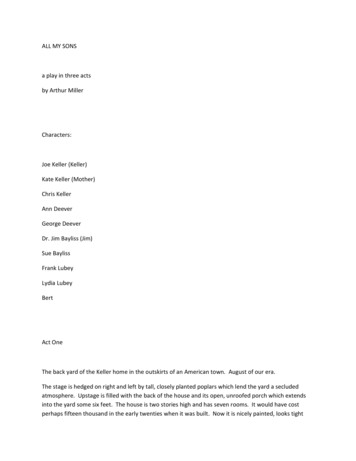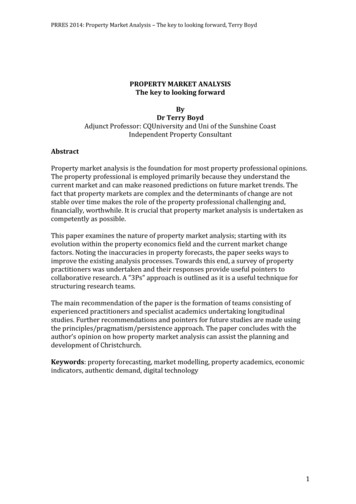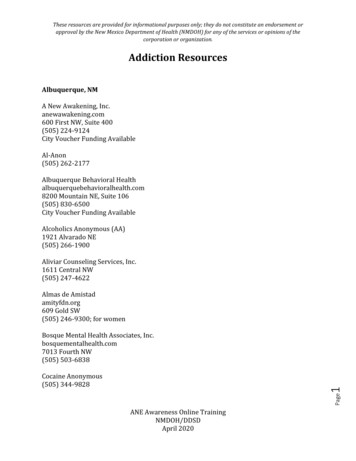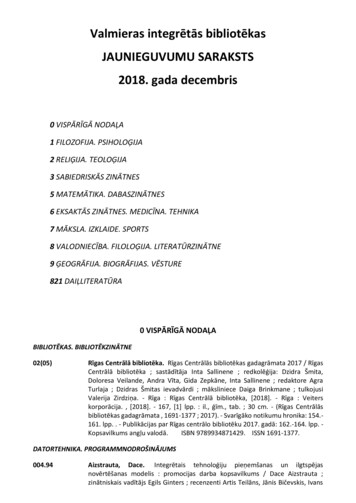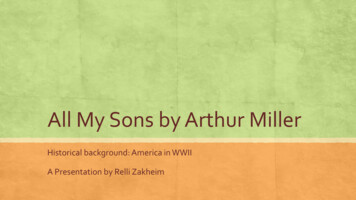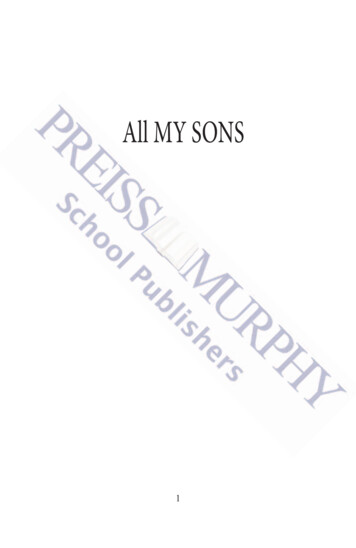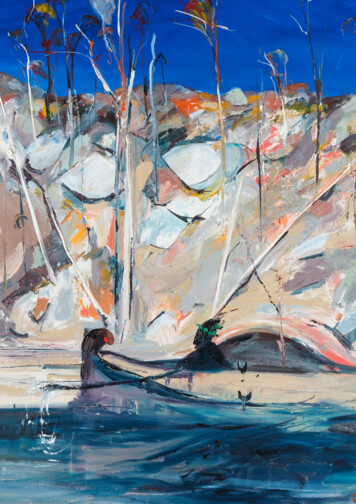
Transcription
1
Cover: Arthur Boyd, Shoalhaven as the River Styx, 1996, oil on canvas (detail). Bundanon family collectionAbove: Arthur Boyd painting en plein air at Bundanon, c1993.
Arthur BoydLandscape of the SoulEducation Guide
2IntroductionThis education guide for the Bundanon Trust touringexhibition, Arthur Boyd: Landscape of the Soul is designedto complement a visit to the exhibition, highlighting the keythemes and providing a series of discussion questions andactivities for students to explore with the guidance of teachers. Choose the discussion questions as appropriate to eachage group and ability. The guide makes substantial use of theexhibition catalogue essay by Barry Pearce.I stress the uniquenessof the Australian landscape& its metaphysical &mythic content.–Arthur BoydThe theme of this exhibition relates to the landscape paintings of Arthur Boyd throughout his career. As a young artistArthur created landscape paintings that celebrated light andrepresented his direct surrounds. He was also concerned withthe application of paint and its tactility on the canvas surface.Through the middle of his career, his landscapes becamemore imagined. Arthur was concerned with the sorrows ofthe human condition, he referenced mythological and biblicalstories to comment on human behaviour and set his imageryin imagined landscapes. Later in his life, Arthur discoveredthe Shoalhaven and with that his joy of light. He used theShoalhaven landscape as a theatrical backdrop to continue toexplore global and personal themes and contemporary issues.The exhibition title relates to the name Merric Boyd gave hisfamily property just before the First World War: Open Country.Here his eldest son, Arthur Boyd, destined to be one ofAustralia’s greatest artists, was born in 1920 in what was thena developing, park-like outer suburb, Murrumbeena, southeast of Melbourne. It was here that Arthur in his early adolescence was determined to set out as a landscape painter.Growing up in the 1920s and 30s at Open Country,signified for Arthur a quest for landscape with ideologicalovertones. Born of entrenched faith, his attitude was simplythat landscape as both idea and materiality could never bepossessed exclusively.Left: Arthur Boyd, House at Murrumbeena, ‘Open country’, 1932-33, oil on board.Right: Emma Minnie Boyd, Open Country, 1921, watercolour on paper
3You can’t owna landscape.–Arthur BoydArthur Boyd grew up within a family of artists, including hisgrandparents Arthur Merric Boyd Senior and Emma MinnieBoyd, and his parents Merric and Doris Boyd. They laid thefoundation of value, in regard to the subject of landscape.Arthur Merric Senior was born in financially comfortablecircumstances, comfortable enough for him to decide ona career as artist. He was admired for his drawing abilityat school and enrolled at the National Gallery School inMelbourne whilst still an adolescent. He was a fellow studentwith artists who went on to form the legendary HeidelbergSchool, in particular, Tom Roberts, Arthur Streeton andFrederick McCubbin. He painted lyrical pastoral landscapes.Emma Minnie, whom he met through family connections,and as a fellow student at the National Gallery School wasalso a very competent watercolourist and had already takenprivate lessons with the immigrant Swiss painter AbramLouis Buvelot. Emma Minnie painted sensitive landscapesin watercolour and detailed oil paintings.Top: Emma Minnie Boyd, Coastal scrub, Sandringham c1927, watercolour on paper.Right: Arthur Merric Boyd, Porth Pean Cornwell, 1892, watercolour on paper.Activity1.1 What is the date on Arthur Merric Boyd’s watercolourPorth Pean Cornwell?1.2 Imagine you are back in that year and you are taking apicnic to this exact spot, describe what you can see as youwalk along the coastline to get to your picnic spot? Whatmight you have packed in your picnic basket? What mightyou be wearing?1.3 Now search Google maps and find the coastline ofPorth Pean Cornwell? What can you see on the beachtoday? Again, imaging you are taking a picnic to this spottoday, what might you see along the coast line, what youtake in your picnic basket and how do you think what wewear has changed?
4Arthur Boyd’s parents, Merric and Doris, also met at theNational Gallery School. Merric’s haptic and sometimesnaïve imagery both in his pottery decorations and drawings, were based on the tree trunks, canopies, root forms andcurvilinear backgrounds of countryside within near reach ofOpen Country, or down on the Peninsula. His images havea strange anthropomorphic effect, as if the roots were veinsand the branches limbs. Merric was known for his iconicwhite gums of the Victorian bush.When Arthur embarked on his first serious landscapesduring the early 1930s, the closest living exemplar for abright avant garde style was provided by his mother, Doris.Discussion1.1 Research online one or two paintings by Abram LouisBuvelot. Considering Buvelot’s works, how do you thinkArthur Merric Senior and Emma Minnie were influencedby his style and techniques?1.2 Compare and contrast Emma Minnie Boyd’spaintings Open Country, 1921 and Coastal scrub,Sandringham, 1927.1.3 Describe the drawing style of Merric Boyd, referringto one or two images in the exhibition.Activity2.1 If you were to name your home, what name wouldyou give it?2.2 Draw an image of your home. Looking at EmmaMinnie Boyd and Arthur Boyd’s images of the house atMurrumbeena, Open Country, think about the viewpointyou would draw it from, the front or back? close up orfar away? What would we be able to see in your image:the garden, big trees, or the shed? Is there a trampoline inyour yard or a long driveway?2.3 If you were to paint your image, what colours wouldyou use? Would you use soft water colours like EmmaMinnie Boyd or thick impressionistic brush strokes likeArthur Boyd?Top: Doris Boyd, Figure in a stormy landscape, 1928, oil on cardboard.Below: Merric Boyd, Landscape, 1944, pencil on paper.
5Theme 2: Genesis& InflectionArthur started painting seriously around 12 years old whilststill at school, from an early stage he showed signs of hismother’s influence: strong colour, loose but definite gestures;and excitement at the prospect of a creative path opening up.Arthur’s brother, David Boyd, recalled Doris’s attitude thatbecame imbedded in all the children: the creative effort oridea was the most important thing of all that it was relatedto life, it was life. For the Boyd family, life and art were interlinked. Family members were often portrayed in artworks.After leaving school at the age of 14, Arthur enrolled in theNational Gallery School and managed six months of nightclasses however he found it unsatisfactory. The saving gracewas his fellow student and cousin Pat Boyd who Arthurfound quite savvy about current techniques of painting.It was Pat who taught him how to use a palette knife, andindirectly brought about his first encounter with a work byEuropean painter Vincent Van Gogh through a postcardowned by Pat’s brother, architect Robin Boyd.Then there was a major moment in 1936 that allowed himto surge ahead with his work. Arthur’s grandmother EmmaMinnie died, Arthur Merric senior moved to a family cottagein Rosebud, on the Mornington Peninsula. He invited hisgrandson to stay with him. Here young Arthur, with someuseful tuition on offer from his grandfather, could concentrate on painting relatively undistracted. The influence ofhis grandfather and painting en plein air became apparent,working quickly and with the natural light of the outdoors.Over the next three years he sent letters to his motherto keep her informed of his progress with little thumbnail sketches, and during visits to the city he would go tothe Primrose Pottery Shop and Gino Nibbi’s LeonardoBookshop to find more illustrations of modern Europeanpainters.Top: Arthur Boyd, Farm building and grazing sheep, 1939, oil on canvas.Below: Extract from a letter Arthur Boyd sent to his mother Doris Boyd, c1937Discussion2.1 Looking at the works in the exhibition, which ones doyou think Arthur Merric Senior and Arthur Boyd mayhave painted en plein air? Describe why you think this.2.2 Look closely at the artworks from this period ofArthur’s career, hung together in the exhibition, describethe colours and texture Arthur uses.2.3 What subject matter did Arthur base his landscapeson during this period?
6Activity3.1 Research a landscape painting by the Post-ImpressionistVincent Van Gogh. Compare his painting techniques witheither of Arthur’s paintings: Orchard with Cherry Blossoms,1939 or Farm building and grazing sheep, c1939.How do you think Arthur was influenced by the work ofVan Gogh?What are the similarities and differences in their styles?3.2 Imagine you are Arthur; how would you describeyour work Pastoral Landscape with Fence, c1936, in a letterback to your parents. Draw three thumb nail sketchesthat Arthur may have included in this letter. Look at theexamples in the display cases of original letters Arthurwrote to his mother from 1936-1939.3.3 Compare Arthur Boyd’s painting Bent tree in a storm,1938, and Hills near Rosebud and stormy sky, c1938, withDoris Boyd’s Figure in a stormy landscape, c1928. Discussunderpainting, brushstrokes and the use of dynamicmovement when painting the natural elements.Arthur returned to Murrumbeena, at the end of the 1930sinfluenced by all the new artists he had encountered. Arthurmet the talented painter Yvonne Lennie, at the NationalGallery School, who later became his wife. He also met theimmigrant Austrian-Polish Jewish painter Yosl Bergner whourged Australian artists to take a closer look at the GermanExpressionists. Boyd had become acquainted with artistsgathered around John and Sunday Reed at Heide: SidneyNolan, Albert Tucker and Joy Hester, who all becamefriends. Closest was John Perceval, who he met after beingconscripted into the Army in 1941.Arthur Boyd, Gardiners creek, 1935, oil on canvas.Kokoshka was wellregarded for his landscapesof cities and their riversand bays, that went beyondtopography and likeness,and plumbed a tremulouslanguage of his inner gaze.–Barry Pearce
7Man launching boat, 1940, is one of the most intriguing paintings by Arthur Boyd of the 1940s. This work is atransitional one, which belongs neither to the optimism ofhis Mornington Peninsula landscapes that preceded it, northe disturbing images of his early war period which followed.Man launching boat references Boyd’s association with theshorelines of his teenage years, when his grandfather, atRosebud on the Mornington Peninsula in Victoria, helpedhim turn a punt into a little sailboat to navigate the waterways of Port Phillip Bay.Arthur followed Bergner’s influence and through reproductions looked at the work of Austrian artist Oskar Kokoshka.Boyd was interested in a postcard of Kokoshka’s mostfamous work, The Tempest (also known as The Bride of theWind), 1913, in which passages of painterly energy dispersedacross a completely flat picture plane. The Tempest alsodepicted a theme of two naked lovers, writhing with unrequited emotion. The tiny boat would become a symbol for areceptacle of passion, which Boyd was to employ later in the1965 work Lovers on fire in a boat with kite.Arthur’s colour palette was often very light during this periodand he was able to manage colour and technique like a musician, choosing at will major or minor keys, lightness or darkness,confounding predictability. Just before both Merric and Dorisdied – Merric in 1959, Doris in 1960 – Arthur began to use amuch darker and heavier impasto. Merric’s death was the trigger for a life-changing exit, with Arthur joining a major exodusof Australian artists to England.Arthur Boyd deeply felt thefutility of war and forgetting of history. Whilst disinterestedin organised politics, Boyd at times joined political actions.He participated in exhibitions protesting against the VietnamWar and commemorating the bombing of Hiroshima, andsigned appeals to the Mexican government for clemency forartist David Sequeriros.Discussion3.1 Curator Barry Pearce describes Man Launchingboat, 1940, as having a “dark encroaching sea” and a“headland arching nervously upwards”. Looking carefullyat the way Arthur Boyd has depicted this scene, describethe viewpoint of the painting and the composition.3.2 Compare Man Launching Boat, 1940 and Lovers onfire in a boat with kite, c1965. These two artworks werepainted 25 years apart and are a great example of howBoyd returned to earlier works for inspiration throughouthis life. Discuss the composition, use of colour andbrushstrokes and sense of movement in the paintings.3.3 Research Oscar Kokoschka, using Google images andsearch text “Polperro II”. Choose one painting which youthink has similarities to Boyd’s Man Launching Boat.Arthur Boyd, Man launching boat, 1940, oil on canvas.ActivityThese questions refer to Picture on the wall Shoalhaven(1979-80)4.1 Describe the artwork Picture on the wall Shoalhaven4.2 Take a journey down both the rivers depicted in theartwork. Describe your journey and the feelings andideas you experience as you travel.4.3 In what way could this artwork be considered to be a“reflection” type of painting, as seen in other worksby Boyd?4.4 Using Google Earth, make a virtual flying journeyover the Shoalhaven River, starting at Nowra. Discussthe experience.4.5 Use Man Launching Boat, 1940, as inspiration for aseries of seascape paintings of your own. Experimentwith viewpoints, focal point, horizon line, colour andtexture.
8This period includes The expulsion, 1947-48, on loan from theArt Gallery of New South Wales, again this work is an example of revealing links with old European masters. This workrecalls Arthur’s childhood in Murrumbeena when Arthur andhis siblings listened fascinated to Old Testament stories readby grandmother Emma Minnie from a Bible with stark illustrations that sometimes terrified the children. From this time,Arthur frequently placed historical and mythological subjectmatter and narratives in the context of the Australian bush.The subject of The expulsion that matters most is the landscape, deep emerald green foliage and russet red rocks aglowlike a stained-glass window, exuding a sublimely beautiful, ifslightly uncomfortable informality of the Australian bush.Following his religious paintings, Arthur moved into temperastyle to a series of landscapes around Frankston, Berwick andHarkaway during 1948-49. These works show rural harmonywhere all signs of disturbance between people and nature haveevaporated.Within a year, Arthur was in the outback, recording openWimmera country under heat and glare, followed in ensuingyears with images of Central Australia such as, The waterhole,Central Australia, 1954, on loan from the National GalleryVictoria. He was aware of the revelatory paintings of his friendSidney Nolan, who had been there in 1949 and created a newawareness of the great red heart of the continent.Arthur Boyd, Berwick landscape, 1948, tempera on composition board. Queensland Art Gallery of Modern Art
9Tempera painting techniquetempera—a method of painting with pigmentsdispersed in an emulsion able to be mixed with water,typically egg yolk. The method was used in Europe forfine painting, mainly on wood panels, from the 12thor early 13th century until the 15th, when it began togive way to oils. Egg tempera was another name forthe technique.The use of tempera in Berwick Landscape,1948, andA’Beckett Road, Harkaway, 1949, is significant. Boththese works were painted on composition board. Inthe early 1940s Boyd spent time at the State Libraryreading books on the old masters. Arthur becameinspired by the world landscape paintings of PieterBrueghel and responded to the luminous translucence of tempera in these works. He researched it ina book recommended by artist Albert Tucker, MaxDoerner’s, ‘The materials of the artist and their usein painting.’According to Doerner, tempera and oil painting arecomplementary techniques. Tempera can be usedas an underpainting followed by glazes (transparentlayers) of oil paint. This technique was used by thegreat masters such as Velasquez. Using neutral, lightcolours, tempera is applied to the prepared canvasor board. The advantages of a tempera underpainting for an oil picture is that a sketchy, simpletempera underpainting which has been paintedwith water or very thin emulsion becomes rapidlydry. Oil colour sits well on lean tempera. A temperaunderpainting shortens the process of painting, andthrough its use the picture becomes more richlyluminous and is protected more against later darkening, than if oil is used as an underpainting.His was an artist’sodyssey through landscape both seen andimagined.–Barry PearceActivityDescribe the qualities of tempera used in Arthur Boyd’sBerwick Landscape, 1948, compared with his oil paintingGardiners creek, 1935DiscussionResearch a work by Pieter Brueghel and compare thiswork with a work by Arthur Boyd from the 1940s,such as Berwick Landscape,1948 or A’Beckett RoadHarkaway,1949. Discuss the placement of figures inspace and the energy of the composition.
10Theme 3: Between WorldsUntil the 1960s, Arthur had depicted the Australian landscape in its diversity, not only topographically but also itsscope for embracing human stories and highly personalsymbolism. Arriving in London at the end of 1959 a newchallenge presented itself that he took on with his usualextraordinary energy.His most powerful paintings of the decade, theNebuchadnezzar series, begun in 1966, were set againstlandscapes of pain and despair.There were many contexts to the Nebuchadnezzar paintings.In many works, Arthur makes use of allegorical themes tomake comments on universal themes of love, vanity, racism,poverty and war.Between 1966 and 1971, during which the first series wasproduced, the war in Vietnam was at its ugliest. Reportsfrom the battle sites, of napalm bombing, wounded the artistto his soul, just as deeply as when he learned about Hitler’streatment of the Jews in the Second World War. But it wasthe self-immolation of a young man assumed by Arthur tohave been in protest that shocked him most profoundly. Ittook place in 1967 on Hampstead Heath, not far from whereArthur and Yvonne lived. Arthur never really recovered, ashe continued to unravel the Old Testament story of a kingbanished, humiliated, to the wilderness for seven years forplacing his own status above God. Nebuchadnezzar with blueflowers and white dog, 1969, depicts a figure bowed beneatha poetic sky with crescent moon and stars indifferent to thetragedy below. A beaten, huddled man intended to be Arthur’sfather, or maybe even Arthur himself.Activity6.1 What are some contemporary issues that you areconcerned with today?6.2 How would you depict these issues as images in apainting or drawing?6.3 Start a sketch of your ideas, use the sketch work ofArthur and the drawing style of Merric as a guide.DiscussionThese questions refer to the Nebuchadnezzarpaintings in Landscape of the Soul; William Blake(1757–1827) was a visionary artist and poet whorepresented Nebuchadnezzar in prints. Research Blake’sNebuchadnezzar and discuss how do you think Arthurwas influenced by Blake.5.1 Describe some of the emotions you feel when lookingat the Nebuchadnezzar paintings?5.2 What techniques have been used to convey emotionalstates in these works?5.3 What meaning is communicated through the use ofcolour in these works?5.4 Discuss the use of rhythm and movement in thecomposition of the Nebuchadnezzar works.5.5 How has Arthur communicated power and control inhis artworks?5.6 Looking at each of the Nebuchadnezzar paintings inLandscapes of the Soul, compare: The depiction of Nebuchadnezzar The application of paint The use of colour5.7 Why would the sky in Nebuchadnezzar with blueflowers and white dog be described as poetic, are thereother poetic elements in any of the other Nebuchadnezzarpaintings?Arthur Boyd, Nebuchadnezzar with blue flowers and white dog, 1969, oil on canvas.
11Nebuchadnezzar SeriesThe Nebuchadnezzar series based on TheOld Testament story of the fall from grace ofNebuchadnezzar, forms a significant body of workfor Arthur Boyd. This series represented highlyinventive responses to religious subject matter. Boyd’spaintings on this theme relate to his fascination withthe visionary art of William Blake and to memoriesof graphic biblical stories read to him as a child byhis grandmother. Nebuchadnezzar was the greatest of the Kings of Babylon who captured and thenlater destroyed Jerusalem. Nebuchadnezzar was bornabout 630 B.C. and died around 562 B.C. at age 68.He was the most powerful monarch of his dynastyand is best known for the magnificence of his capital,Babylon. During Nebuchadnezzar’s time, Babylonwas the largest city in the world, with the EuphratesRiver flowing through it. The name of the city cameto symbolise the entire empire.Nebuchadnezzar was a successful ruler whoengaged in many military campaigns. Best knownthrough biblical accounts in the Old TestamentBook of Daniel, he is said to have become carriedaway with his power to the point of thinking himselfGod-like. Punished for his pride and arrogance,Nebuchadnezzar was cast into the wilderness forseven years, undergoing many trials and tribulations. Arthur Boyd often drew inspiration from theBible and ancient mythology. Sometimes he placedthese themes in the midst of the Australian landscape. In this series, Arthur was responding to thesuffering and madness around him. The story ofNebuchadnezzar gave rise to a series of powerfuland disturbing paintings, perhaps the most chargedand challenging of Boyd’s work, commenting onthe Vietnam War. In this series, which he workedon from the mid-1960s to early 1970s (revisitedin the 1990s), Boyd equates Nebuchadnezzar withAmerica wading into the Vietnam War. The series ispermeated with intense anger at the urgent politicalissues posed by Vietnam, while simultaneously grappling with many of the psychological themes withwhich Boyd struggled throughout his career.Arthur Boyd, Red Nebuchadnezzar fallen in a forest with lion, 1969, oil on canvas.I’d like to feel that through mywork there is a possibility ofmaking a contribution to a socialprogression or enlightenment. Itwould be nice if the creative effortor impulse was connected with aconscious contribution to society, asort of duty of service.–Arthur Boyd
12Arthur returned to Australia in October 1971 to take upa three-month Creative Art Fellowship at the AustralianNational University in Canberra. In December he andYvonne were invited by art dealer Frank McDonald to spendChristmas at his property Bundanon in southern New SouthWales. Here, for the first time in many years, the artist set uphis canvas and began en plein air painting, in the open, and inwithering heat, Arthur watched his paint melt into the sand.He remained there inspired for several weeks, on the cusp ofanother dawn, a possibility of being refreshed, re-immersinghimself once more in pure landscape painting.Discussion6.1 Discuss the link between the figures and thelandscape in Lovers on fire in a boat with kite.6.2 Compare the depiction of the figures in the landscape inLovers on fire in a boat with kite with Figure and beast head.6.3 One of these paintings was painted in Australia andthe other in England. In your opinion, which is which andwhy do you think this?6.4 Man digging and crows reveals significant influenceof Arthur’s mother Doris Boyd. Describe three linksbetween their styles.6.5 Find the artwork in Landscape of the soul which isinfluenced by both Doris Boyd and Van Gogh.Arthur Boyd, Lovers on fire in a boat with kite, 1965 oil on canvas.The two frail, naked bodies,harassed from the bushby an avenging angel inradiant yellow cloak in Theexpulsion remind us alsoof the trauma of Arthurand his wife-to-be Yvonnesecretly liaising in thebush in 1942 at Bendigowhilst he was meant to bein Army camp, and latersprung by the authoritiesfor stealing blankets.–Barry Pearce
13Theme 4: Shoalhaven yearsAfter his stay at Bundanon over the summer of 1971-72,Arthur returned to England in March with the dazzlingShoalhaven light fixed firmly in his mind.In 1971-72 at Bundanon, he had asked his host to look outfor a property in the area that he and Yvonne could purchase.The following year they bought Riversdale, a run-down farmnestled in a valley right next to the Shoalhaven River.From their large living room, they could see the sky turnmauve then indigo behind the huddled blackness across thewater, and on a clear night the bright stars that slowly multiplied as the evening deepened. In high summer the air couldbe so fiercely hot that light carved out the shapes of rocks likea burning scalpel. Arthur witnessed the serious flood of 1974,after endless days of rain, and the river heaved its great brownmass towards the sea.In 1979 Arthur and Yvonne bought nearby Bundanon,expanding further the variety of landscape at his disposal,infused with themes of Christ, the Prodigal Son, Pushkin’sfairy tales, Narcissus and Cuchulain the mythical Irishwarrior, to name a few, capitalising on the dramatic possibilities of shadows from rocks and trees appearing hard ‘likeblack holes’.Arthur made many pure landscape paintings of theShoalhaven, a few of almost mural-size dimension, but someof the most beautiful are small in scale.Left: Arthur Boyd, Trees on a hillside, Riversdale, 1975, watercolour on paper.Right: Arthur and Yvonne Boyd at BundanonDiscussion7.1 What do you think pure landscape means?7.2 List the works from Landscape of the Soul,Shoalhaven years, that you consider to be purelandscapes.ActivityThe Shoalhaven was a very special place for ArthurBoyd. You would have a place that has special meaning inyour life (at school or at home)?Develop three sketches of this place, which you can lateruse in a plein air painting.DiscussionRefer to Hanging rocks with Bathers and Mars:8.1 Describe the images in each of the foreground,middle ground and background.8.2 Describe the use of space in this composition and thebalance created by the figures and landscape elements8.3 How does this artwork combine the past and present?8.4 This artwork combines elements of the imagined,remembered and real. Describe one example for each ofthe three elements.
14The scale of everything wasso different: the scale of theShoalhaven was enormouscompared to the softness andgentleness of Port Phillip Bayespecially around the Rosebudarea, and also the harshnessof the light not so much theharshness but the clarity. Attimes it was intense the shadowsbecame almost black.–Arthur BoydIn both life and art Arthur Boyd evoked a social conscienceand concern for the world. Boyd’s art arose from an activewitnessing of life, and a concern for the world in the face ofhistory. Humankind’s recklessness is foretold in the burningbook observed by Mars in Hanging rocks with bathers andMars, 1985. Both humans and gods appear detached fromtheir environment, guarding as well as actively despoiling aworld understood as a resource.The landscape in this painting shows signs of regrowthafter fire and finds a resemblance between the form in thedistance and a nuclear power plant located close to Boyd’sSuffolk studio in England. Arthur was aware of the changing character of the Australian landscape across recordedhistory, prior to human impact.In many works, Arthur makes use of allegorical themesto make comments on universal concepts of love, vanity,racism, poverty, war and death. He was also interested inusing his paintings to investigate metamorphosis, oftenusing his repeated symbols such as man or landscape toconvey a transformation into something else such as animalor mythical creature or the transformation from life to death,often not representing one or the other but lingering inbetween.In Pulpit rock, kite and skull, Arthur depicts the story ofFlame; the daughter of a previous owner of Bundanon hada chestnut horse of that name. During a time of flood FlameArthur Boyd, Waterfall and rockface at Shoalhaven Valley, 1975, watercolour and gouache on paperArthur Boyd, Untitled (Shoalhaven Valley), c1970s, ink on paper.
15became trapped in some barbed wire and died from a heartattack. The horse was then buried under a coral tree in thepaddocks. On hearing this story Arthur set about findingFlame and dug up the skeleton. Flame’s skull now hangsabove the door of the studio and became a recurring imagein Arthur’s work.At last Arthur committed himself permanently to thebeckoning Shoalhaven. And that in the end was closest towhat his quest had been all about since Murrumbeena.Never entirely one thing or another but, some kind of grand,complex coalescence, a synthesis between a sense of placeand its creative potential for himself, his family and thepeople of Australia.Discussion9.1 In discussion point 2.3 you were asked to discuss thetype of subject matter that Arthur based his landscapeson during the early stages of his career. Let’s return tothe same question for his Shoalhaven years, what subjectmatter did Arthur base his landscapes on during thisperiod?Top: Arthur Boyd, Hanging rocks with bathers and Mars, 1985, oil on boardBelow: Arthur Boyd, Pulpit rock, kite and skull, c1981, oil on canvas.
16Appropriation: father & sonArthur was interested in rediscovering the worksof his father and highlights their shared interest inmetamorphosis; however, represented in different forms.Arthur was not very explicit about it at the time, but itturned out that he saw the Chaldean King of Babylon:Nebuchadnezzar, as the alter-ego of Merric. Arthuroften appropriated the imagery of his father Merric, oneexample is the trees for Nebuchadnezzar in a clearing,painted a decade after Merric’s death in 1959, in whichan unhappy figure and its landscape seem organicallyconnected.Discussion10.1 Many artists reinterpret artworks by other artistsand use aspects of these in their own works. It is atechnique called appropriat
Arthur Boyd, Gardiners creek, 1935, oil on canvas. Activity 3.1 Research a landscape painting by the Post-Impressionist Vincent Van Gogh. Compare his painting techniques with either of Arthur’s paintings: Orchard with Cherry Blossoms, 1939 or Farm building and grazing sheep, c1939. How do

